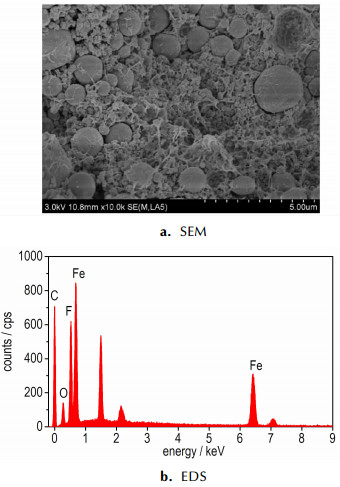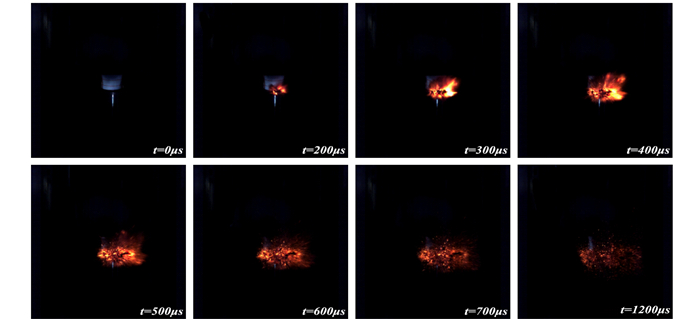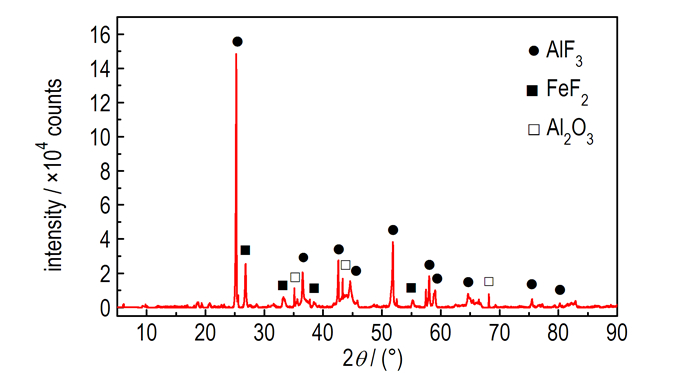2. 中国人民解放军31104部队, 江苏 南京 210007
2. 31104 troop of PLA, Nanjing 210007, China
铝热剂是一种典型的含能材料, 由于其能量密度高, 安全性好, 且铝热反应能够放出大量的热, 因此, 铝热剂广泛用于金属焊接、安全气囊点火、推进剂以及烈性炸药添加剂等领域[1-3]。近年来, 对铝热剂的研究多集中于将铝热剂纳米化, 制造亚稳态分子间化合物(Metastable Intermolecular Composites, MICs)或者超级铝热剂(Superthermite)[4-6]。制备的方法主要有溶胶-凝胶法(Sol-gel)[7-8]、超声机械混合法[9-10]、抑制反应球磨法(ARM)[6, 11]、磁控溅射法[12]等, 研究内容多集中在铝热剂的发火性能, 例如燃烧速率[8-9], 绝热火焰温度[13-14]、感度[15]等。如Michelle L等[9]使用机械混合法制备了Al/MoO3铝热剂, 研究了Al粒径、当量比、体积密度对铝热剂燃烧性能的影响, 王毅等[7]使用溶胶-凝胶法制备了Al/Fe2O3纳米复合铝热剂, 利用扫描电子显微镜(Scanning Electron Microscope, SEM)、能谱仪(Energy Dispersive Spectrometer, EDS)、X射线衍射仪(X-ray diffractometer, XRD)和差示扫描量热法(Differential Scanning Calorimetry, DSC)对样品的形貌、结构和热反应特性进行表征。总体上纳米铝热剂的性能均优于传统的微米级铝热剂, 是一种应用价值极大的新型含能材料。
铝热剂难以成型, 常规情况下只能作为粉末态使用, 大大限制了其应用场景。很多学者尝试在铝热剂的基础上加入聚合物作为基体来制备多功能结构性含能材料, 聚合物基体能够在颗粒之间传递外界施加的载荷, 因此这种材料具有更好的机械强度和更高的感度[16-18], 同时更容易加工成型(比如模压)。Louis Ferranti[16]和J. L.Jordan等[18]在Al/Fe2O3的基础上加入环氧树脂(exopy)作为粘合剂, 研究了Al/Fe2O3/epoxy的动态冲击响应、状态方程, 但直到施加的压力达到23GPa, 也未观察到该材料有化学反应产生, 作者认为是过多的epoxy阻碍了Al和Fe2O3的接触, 进而抑制了反应的发生。然而, 采用聚四氟乙烯(Polytetrafluoroethylene, PTFE)作为粘合剂, 不仅能够增强材料的机械性能, 防水性, 且PTFE能够与Al发生剧烈反应, 放出大量的热能[19-21], 10%的PTFE加入就能使Al/Fe2O3达到放热峰值的时间缩小两个量级[22], 大大提高了复合材料的能量释放水平。
本研究在Al/Fe2O3的基础上, 加入不同含量的PTFE作为粘合剂, 制备了多功能结构性Al/Fe2O3/PTFE含能材料, 使用SEM、EDS、XRD对材料进行了表征, 研究了该复合材料在准静态压缩情况下的力学性能和落锤冲击条件下反应特性, 并对其反应过程进行了简要阐述。
2 实验部分 2.1 试剂与仪器PTFE(25 μm, 上海三爱富新材料股份有限公司); Al(1~2 μm, 上海乃欧纳米科技有限公司); Fe2O3(1 μm, 上海乃欧纳米科技有限公司); 无水乙醇(分析纯, 南通市耀鑫化工有限公司)。
液压机(FLS30T型, 泰州市荣美液压机械制造有限公司); 真空烘箱: DZG-6050型, 杭州卓驰仪器有限公司); 管式炉(TL1200型, 广州儒瑞科技有限公司); 微机控制电子万能试验机(CMT5105型, 美特斯工业系统(中国)有限公司); 落锤冲击试验机(JL-30000型, 济南商泰试验仪器有限公司); 扫描电子显微镜(Hitachi S-4800);能谱仪(Bruker AXS); X射线衍射仪(Bruker D8 ADVANCE)。
2.2 试样制备由于过少的PTFE无法使Al/Fe2O3/PTFE材料成型, 因此在Al/Fe2O3基础上加入体积分数为40%、60%、80%的PTFE, 以研究不同PTFE含量对复合材料力学和反应性能的影响, 相应的试样编号分别为1#, 2#, 3#, 见表 1。同时, 参照1#试样中PTFE与Fe2O3的比例制备了Fe2O3/PTFE复合材料(试样编号为4#), 用于研究落锤冲击试验中PTFE与Fe2O3的反应情况。试样制备过程可参考文献[23], 简单归纳如图 1所示。
| 表 1 试样编号与配方 Tab.1 Sample number and formulation |

|
图 1 Al/Fe2O3/PTFE复合材料制备工艺流程图 Fig.1 Flowchart of Al/Fe2O3/PTFE composite material preparation |
将混合均匀的粉末状试样模压成型为Φ10 mm×10 mm的圆柱形试样用于准静态压缩实验, Φ10 mm×3 mm的圆柱形试样用于落锤冲击实验, 烧结温度为360 ℃。
2.3 准静态压缩力学性能测试压缩力学性能测试按照GB/T7314-2005《金属材料室温压缩试验方法》标准, 使用微机控制电子万能试验机进行测试。测试之前, 在试样两端均匀涂抹凡士林以减小摩擦。试验机压头以6 mm·min-1的速度向下对试样施加压缩载荷, 对应试样的应变率为0.01 s-1。
2.4 落锤冲击试验用落锤冲击试验机研究材料的撞击感度以及反应特性, 依据GJB772A-1997 601.2《撞击感度特性落高法》测试撞击感度, 落锤质量10 kg, 最大落高120 cm, 并使用高速摄影精确判定试样是否发火。
力学测试与冲击试验均在室温25 ℃下完成, 为确保试验的可重复性, 相同试验重复10次。
3 结果与讨论 3.1 Al/Fe2O3/PTFE复合材料的表征三种试样(1#, 2#, 3#)的组成与形貌相似, 以2#试样为例进行表征。利用高分辨扫描电镜(SEM)和能谱仪(EDS)观测2#试样烧结后的微观形貌以及元素组成, 结果如图 2所示。从2a中可以看出, Al和Fe2O3颗粒均匀“镶嵌”在PTFE基体中, 界面结合较为紧密。由图 2b可知, 样品中仅含有F、C、Al、Fe、O五种元素, 没有其他杂质, 元素相对含量如表 2所示, 接近2#样品的理论值, 说明试样混合较为均匀。

|
图 2 Al/Fe2O3/PTFE复合材料(2#)的SEM图像和EDS图谱 Fig.2 SEM image and EDS pattern of Al/Fe2O3/PTFE composites(2#) |
| 表 2 2#试样中元素含量 Tab.2 The element content of sample 2# |
对烧结后的2#试样进行XRD表征, 结果如图 3所示。由图 3可看出, 原材料在经过混合、模压、烧结等一系列工序后, 并未发生化学反应, 材料确为Al/Fe2O3/PTFE。

|
图 3 烧结后Al/Fe2O3/PTFE复合材料(2#)的XRD图谱 Fig.3 XRD patterns of sintered Al/Fe2O3/PTFE composites(2#) |
采用万能试验机对三种试样(1#, 2#, 3#)进行准静态压缩测试, 其真实应力-应变曲线如图 4所示。

|
图 4 Al/Fe2O3/PTFE复合材料(1#, 2#, 3#)的真实应力-应变曲线 Fig.4 The true stress-strain curves of Al/Fe2O3/PTFE composites(1#, 2#, 3#) |
从图 4可以看出, 随着PTFE含量的增加, 材料压缩强度及最大真实应变逐渐增大, 而弹性模量基本保持不变(见表 3), 这是由于弹性变形主要由PTFE基体中较软的无定型态部分承担, 主要表现为无定型态非晶区的层间滑移(interlamellar slip), 这一过程是可逆的[24], 因此, 三种试样的弹性模量基本相当。在Al/Fe2O3/PTFE复合材料中, PTFE是主要的受力组分, 较少的PTFE(1#), 无法将Al、Fe2O3颗粒均匀包覆, 在受压过程中, 很容易产生“脱粘”现象, 导致材料在经历弹性形变后, 很快失效, 强度只有16 MPa, 真实应变值仅有0.06。随着PTFE的增加(2#, 3#), Al、Fe2O3颗粒在PTFE基体中分布更加均匀, 基体与增强相颗粒之间结合更加紧密(如图 2a), 材料的密度也随之增大(表 3), 因此, 材料压缩强度及最大真实应变逐渐增大, 总体力学性能更好。
| 表 3 Al/Fe2O3/PTFE复合材料(1#, 2#, 3#)的力学性能 Tab.3 Mechanical properties of Al/Fe2O3/PTFE composites |
在落锤冲击下(落高为120 cm), 1#和2#试样均发出巨大的爆炸声, 随后转为剧烈的燃烧, 发出明亮的火光, 反应过程如图 5、图 6所示。3#试样反应过于微弱, 在高速摄影下仅观察到微弱的火星, 因此未列出其反应过程。由图 5和图 6可见, 1#试样燃烧时间长达10000 μs, 而2#试样仅为1200 μs, 且1#试样燃烧明显比2#剧烈, 这是由试样的配比决定的。1#试样虽然强度较低, 但Al和Fe2O3含量更高, 因此, 发火后燃烧也更加完全和剧烈。

|
图 5 1#试样落锤冲击下的反应过程(落高120 cm) Fig.5 Reaction process of sample 1# under drop-weightimpact (drop height 120 cm) |

|
图 6 2#试样落锤冲击下的反应过程(落高120 cm) Fig.6 Reaction process of sample 2# under drop-weightimpact (drop height 120 cm) |
表 4列出了三种试样(1#, 2#, 3#)在落锤冲击下的性能参数。由表 4可见, 复合材料的发火延时(通过高速摄影估算得出)和特性落高H50(即试样在此高度冲击下, 有50%的发火概率)随着PTFE的增加而增加, 燃烧时间随着PTFE的增加而减少。这是因为随着PTFE增加, 参与反应的Al以及Fe2O3相应地减少, 导致燃烧时间逐渐降低; 同时PTFE的高延展性和低硬度会缓冲试样受到的冲击, 因此需要更多的能量来触发Al/Fe2O3/PTFE的反应, 导致试样的特性落高H50和发火延时逐渐增加。
| 表 4 Al/Fe2O3/PTFE复合材料落锤冲击下性能参数 Tab.4 Drop-weight impact property parameters of Al/Fe2O3/PTFE composites |
陶忠明等[25]在研究Al/Fe2O3/PTFE材料在落锤冲击下的反应性能时, 观察到了高温熔渣喷射现象, 并与PTFE-Al在落锤冲击下的现象进行对比, 认为确实发生了铝热反应, 但未给出有力证据。为此, 本研究对1#材料的落锤产物进行XRD分析, 以证实Al与Fe2O3之间发生了铝热反应。
1#材料落锤冲击反应后产物的XRD分析结果如图 7所示。由图 7可见, 产物中含有AlF3、Al2O3、FeF2, 同时1#材料反应后有大量黑色固体残渣生成, 认为是非晶态的C(炭黑)。因此, 分析可能发生了如下反应:

|
图 7 1#材料落锤冲击反应后产物的XRD图谱 Fig.7 XRD patterns of reaction products of sample 1# after drop-weight impact |
| $ 4{\rm{Al}} + 3{{\rm{C}}_{\rm{2}}}{{\rm{F}}_{\rm{4}}}{\rm{ = 4Al}}{{\rm{F}}_{\rm{3}}}{\rm{ + 6C}} $ | (1) |
| $ {\rm{2Al + F}}{{\rm{e}}_{\rm{2}}}{{\rm{O}}_{\rm{3}}}{\rm{ = A}}{{\rm{l}}_{\rm{2}}}{{\rm{O}}_{\rm{3}}}{\rm{ + 2Fe}} $ | (2) |
| $ {\rm{2Fe + }}{{\rm{C}}_{\rm{2}}}{{\rm{F}}_{\rm{4}}}{\rm{ = 2Fe}}{{\rm{F}}_{\rm{2}}}{\rm{ + 2C}} $ | (3) |
G.J. Puts和P.L. Crouse[26]在研究金属氧化物对PTFE热分解的影响时, 发现Fe2O3对PTFE的分解几乎没有影响, 即PTFE和Fe2O3之间不存在化学反应。同时, 本研究制备的PTFE/Fe2O3复合材料(4#), 在落锤冲击下也未观察到任何反应现象。因此, 本研究认为在低加热速率下(<104 K/s, 落锤冲击、DSC均属于这一范畴), PTFE与Fe2O3之间不会发生化学反应, 故FeF2不是PTFE与Fe2O3反应的产物, 而是由铝热反应产生的Fe与PTFE分解产物(主要是C2F4)之间的化学反应产生的。
4 结论在Al/Fe2O3基础上加入不同体积分数的PTFE作为粘合剂, 研究了该复合材料在准静态压缩情况下的力学性能和落锤冲击条件下反应特性, 并对其反应过程进行了分析。研究结果表明:
(1) 随着PTFE含量的增加, Al/Fe2O3/PTFE材料的压缩强度、应变硬化模量、屈服强度、密度以及最大真实应变逐渐增大。40%的PTFE无法将Al、Fe2O3颗粒均匀包覆, 在受压过程中, 很容易产生“脱粘”现象。而随着PTFE含量的增加, 基体与增强相颗粒之间结合更加紧密, 材料强度逐渐增加。
(2) PTFE含量为40%和60%的Al/Fe2O3/PTFE复合材料均能在落锤冲击下发生剧烈爆炸和燃烧, 而加入80%PTFE的复合材料在高速摄影下也仅观察到微弱的火星, 反应十分微弱。随着PTFE的增加, 复合材料的感度逐渐降低, 发火延时逐渐增加。
(3) 1#材料落锤冲击后产物为AlF3、Al2O3、FeF2以及非晶态的C, 证实了铝热反应的发生。FeF2不是PTFE与Fe2O3反应的产物, 而是由铝热反应产生的Fe与PTFE分解产物(主要是C2F4)之间的化学反应产生的。
| [1] |
Plantier K B, Pantoya M L, Gash A E. Combustion wave speeds of nanocomposite Al/Fe2O3: the effects of Fe2O3 particle synthesis technique[J].
Combustion & Flame, 2005, 140(4): 299-309. |
| [2] |
Piercey D G, Klapötke T M. Nanoscale aluminum-metal oxide (thermite) reactions for application in energetic materials[J].
Central European Journal of Energetic Materials, 2010, 7(2): 115-129. |
| [3] |
安亭, 赵凤起, 裴庆, 等. 超级铝热剂的制备、表征及其燃烧催化作用[J].
无机化学学报, 2011, 27(2): 231-238. AN Ting, ZHAO Feng-qi, PEI Qing, et al. Preparation, characterization and combustion catalytic activity of nanopaticle super thermites[J]. Chinese Journal of Inorganic Chemistry, 2011, 27(2): 231-238. |
| [4] |
Michelle LPantoya, Granier J J. The effect of slow heating rates on the reaction mechanisms of nano and micron composite thermite reactions[J].
Journal of Thermal Analysis & Calorimetry, 2006, 85(1): 37-43. |
| [5] |
Petrantoni M, Rossi C, Conédéra V, et al. Synthesis process of nanowired Al/CuO thermite[J].
Journal of Physics and Chemistry of Solids, 2010, 71(2): 80-83. DOI:10.1016/j.jpcs.2009.07.020 |
| [6] |
Schoenitz M, Ward T, Dreizin E L. Preparation of Energetic Metastable Nano-Composite Materials by Arrested Reactive Milling[C]//Mrs Online Proceedings Library Archive, 2003: 800.
https://www.researchgate.net/publication/274296642_Preparation_of_Energetic_Metastable_Nano-Composite_Materials_by_Arrested_Reactive_Milling |
| [7] |
王毅, 李凤生, 姜炜, 等. Fe2O3/Al纳米复合铝热剂的制备及其反应特性研究[J].
火工品, 2008(4): 11-14. WANG Yi, LI Feng-sheng, JIANG Wei, et al. Synthesis of Fe2O3/Al nanocomposite and research on its thermite reaction[J]. Initiators & Pyrotechnics, 2008(4): 11-14. |
| [8] |
Plantier K B, Pantoya M L, Gash A E. Combustion wave speeds of nanocomposite Al/Fe2O3: the effects of Fe2O3 particle synthesis technique[J].
Combustion & Flame, 2005, 140(4): 299-309. |
| [9] |
Michelle L Pantoya, John J Granier. Combustion behavior of highly energetic thermites: Nano versus micron composites[J].
Propellants, Explosives, Pyrotechnics, 2005, 30(1): 53-62. DOI:10.1002/(ISSN)1521-4087 |
| [10] |
Cheng J L, Hng H H, Ng H Y. Synthesis and characterization of self-assembled nanoenergetic Al-Fe2O3 thermite system[J].
Journal of Physics & Chemistry of Solids, 2010, 71(2): 90-94. |
| [11] |
Basset D, Matteazzi P, Miani F, et al. Kinetic effects in the mechanically activated solid-state reduction of haematite[J].
Hyperfine Interactions, 1994, 94(1): 2235-2238. DOI:10.1007/BF02063768 |
| [12] |
Bahrami M, Taton G, Conédéra V, et al. Magnetron sputtered Al-CuO nanolaminates: Effect of stoichiometry and layers thickness on energy release and burning rate[J].
Propellants, Explosives, Pyrotechnics, 2014, 39(3): 365-373. DOI:10.1002/prep.201300080 |
| [13] |
Bazyn T, Glumac N, Krier H, et al. Reflected shock ignition and combustion of aluminum and nanocomposite thermite powder[J].
Combustion Science & Technology, 2007, 179(3): 457-476. |
| [14] |
Fischer S H, Grubelich M C. Theoretical energy release of thermites, intermetallics, and combustible metals[R]. Monterey: Office of Scientific & Technical Information Technical Reports, 1998.
https://www.osti.gov/biblio/658208 |
| [15] |
Hunt E M, Malcolm S, Pantoya M L, et al. impact ignition of nano and micron composite energetic materials[J].
International Journal of impact Engineering, 2009, 36(6): 842-846. DOI:10.1016/j.ijimpeng.2008.11.011 |
| [16] |
Jr L F, Thadhani N N. Dynamic mechanical behavior characterization of epoxy-cast Al+Fe2O3 thermite mixture composites[J].
Metallurgical & Materials Transactions A, 2007, 38(11): 2697-2715. |
| [17] |
Park Y, Seo S, Jang S, et al. Investigation of shear induced exothermic thermite reaction in Al-Fe2O3-epoxy cast composites[J].
Combustion Science & Technology, 2016, 188(6): 895-909. |
| [18] |
Jordan J, Dick R, Ferranti L, et al. Equation of state of aluminum-iron oxide (Fe2O3)-epoxy composite[J].
American Institute of Physics, 2006, 845(1): 157-160. |
| [19] |
冯彬, 方向, 李裕春, 等. 10-2 s-1压缩应变率下Al-Teflon的反应现象[J].
含能材料, 2016, 24(6): 599-603. FENG Bin, FANG Xiang, LI Yu-chun, et al. Reaction of Al-Teflon under 10-2 s-1 compression strain rate[J]. Chinese Journal of Energetic Materials(Hanneng Cailiao), 2016, 24(6): 599-603. DOI:10.11943/j.issn.1006-9941.2016.06.015 |
| [20] |
Feng B, Fang X, Li Y C, et al. Reactions of Al-PTFE under impact and quasi-static compression[J].
Advances in Materials Science & Engineering, 2015: 1-6. DOI:10.1155/2015/582320) |
| [21] |
Watson K W, Pantoya M L, Levitas V I. Fast reactions with nano- and micrometer aluminum: A study on oxidation versus fluorination[J].
Combustion & Flame, 2008, 155(4): 619-634. |
| [22] |
Petersberg S.
Shock induced chemical processing[M]. Washington: US Army Research Office, 1997: 73-76.
|
| [23] |
黄骏逸, 方向, 李裕春, 等. PTFE/Al/Fe2O3复合材料的性能[J].
工程塑料应用, 2017, 45(8): 6-10. HUANG Jun-yi, FANG Xiang, LI Yu-chun, et al. Properties of PTFE/Al/Fe2O3 composites[J]. Engineering Plastics Application, 2017, 45(8): 6-10. |
| [24] |
Jordan J L, Siviour C R, Foley J R, et al. Compressive properties of extruded polytetrafluoroethylene[J].
Polymer, 2007, 48(14): 4184-4195. DOI:10.1016/j.polymer.2007.05.038 |
| [25] |
陶忠明, 方向, 李裕春, 等. Al/Fe2O3/PTFE反应材料制备及性能[J].
含能材料, 2016, 24(8): 781-786. TAO Zhong-ming, FANG Xiang, LI Yu-chun, et al. Preparation and performances of the Reactive Al/Fe2O3/PTFE material[J]. Chinese Journal of Energetic Materials(Hanneng Cailiao), 2016, 24(8): 781-786. DOI:10.11943/j.issn.1006-9941.2016.08.010 |
| [26] |
Puts G J, Crouse P L. The influence of inorganic materials on the pyrolysis of polytetrafluoroethylene. Part 2: The common oxides of Al, Ga, In, Zn, Cu, Ni, Co, Fe, Mn, Cr, V, Zr and La[J].
Journal of Fluorine Chemistry, 2014, 168(4): 9-15. |

Al/Fe2O3/PTFE multifunctional energetic materials were prepared by adding different volume fractions of PTFE as binder on the basis of Al/Fe2O3. The morphology, mechanical properties and reaction behaviours of the composite were studied by SEM, quasi-static compression experiments and drop-weight test respectively. The reaction residues were analyzed by XRD and the reaction process were discussed.




